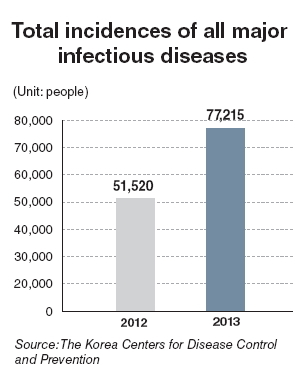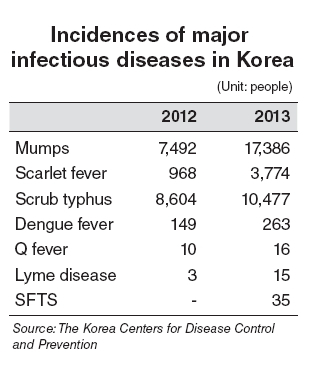
A total of 77,215 Koreans came down with infectious diseases in 2013, up about 50 percent from the previous year, the Korea Centers for Disease Control and Prevention said. Tick-borne infections took a bigger share, as their habitats moved north as the average temperatures went up.
“The Korean Peninsula’s climate is turning subtropical and more people are coming in and out of the country,” said Kim Woo-joo, professor of infectious disease at the Korea University Guro Hospital. “We have to take steps to prevent new diseases from spreading in the country.”
The change in the environment, possibly initiated by global warming, has been linked to the spike in the number of new infections in Korea such as scrub typhus, a febrile illness caused by Rickettsia tsutsugamushi bacteria and characterized by fever, headaches, rashes and eschar formation, or scabbing. Scrub typhus is also known as tsutsugamushi disease or Japanese river fever.

Experts said a growing number of Koreans are traveling to rural and remote areas where the risk of contracting infectious diseases is high, leading to the spread of diseases such as dengue fever and severe fever with thrombocytopenia syndrome, also known as SFTS.
SFTS, which has a fatality rate of as high as 30 percent, was found for the first time in Korea last year. Among the 35 people who were infected, seven died.
The country saw 263 people coming down with dengue fever in 2013, up 77.2 percent from a year earlier.
Tick-borne diseases such as Q fever and lyme disease also showed a growth trend, with 16 and 15 patients identified,
By Suk Gee-hyun (monicasuk@heraldcorp.com)







![[KH Explains] Hyundai's full hybrid edge to pay off amid slow transition to pure EVs](http://res.heraldm.com/phpwas/restmb_idxmake.php?idx=644&simg=/content/image/2024/04/18/20240418050645_0.jpg&u=20240419100350)






![[From the Scene] Monks, Buddhists hail return of remains of Buddhas](http://res.heraldm.com/phpwas/restmb_idxmake.php?idx=652&simg=/content/image/2024/04/19/20240419050617_0.jpg&u=20240419175937)

![[KH Explains] Hyundai's full hybrid edge to pay off amid slow transition to pure EVs](http://res.heraldm.com/phpwas/restmb_idxmake.php?idx=652&simg=/content/image/2024/04/18/20240418050645_0.jpg&u=20240419100350)

![[Today’s K-pop] Illit drops debut single remix](http://res.heraldm.com/phpwas/restmb_idxmake.php?idx=642&simg=/content/image/2024/04/19/20240419050612_0.jpg&u=)